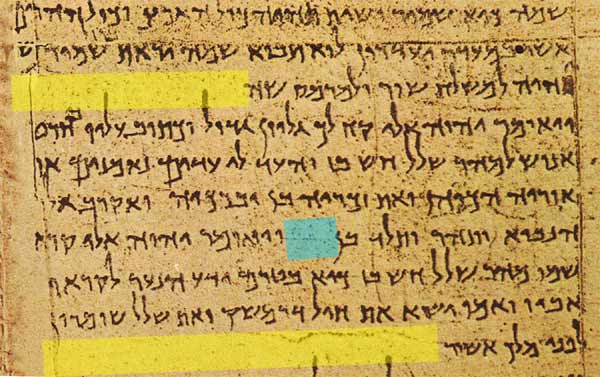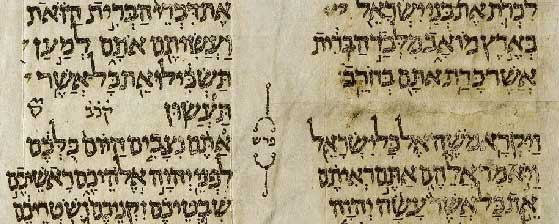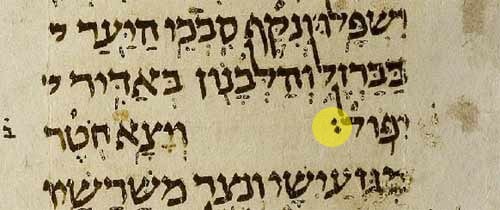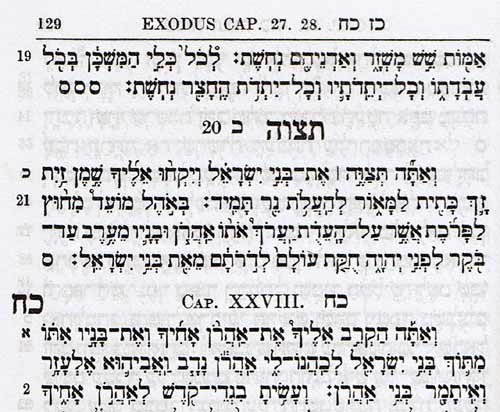The complex story on the present chapter and numbering system of the Hebrew Bible.
The present book divisions, chapters, verses and structure of the Bible were standardized in the sixteenth-century. One would think this would apply exclusively to the Christian editions of the Bible, but has been administered retroactively to ancient Hebrew Bibles as well.
Most would assume the Hebrew Bible is so old and carefully guarded that the text has been standardized for almost 2000 years. This is not so when it comes to book names, chapters and numbering. The Hebrew versions popularly available today are considerably different from the Dead Sea Scrolls when it comes to format structure.
To understand the problem, one has to uncover the history of the Hebrew Bible.
Book structure as it is found in the Dead Sea Scrolls.
The best place to start is with the handwritten Great Isaiah Scroll written between 125-100 BC. This text comprised two methods to break up copy into paragraphs, but did not have chapters. Instead, it had:
- One or two words as orphans on a line with complete white space until the next line. This is the end of a distinct literary unit.
- Having a four to nine character white space between words, which would simply be interpreted today as the end of a paragraph.
The sample below is taken from Isaiah 7:25-8:5. It is a demonstration of long spacing representing a literary unit, and short spacing for a paragraph within a literary unit.1
It may not be so obvious so the same image is supplied below with highlights. The yellow highlights are to demonstrate the long blank spaces that represent where a literary unit has ended and the next one should begin. The small blue highlight represents a paragraph within the same literary unit.
Why the ancient book structure had to be modified.
By the 9th century AD, Hebrew died as an active tongue. The writing system lacked vowels and just had consonants. The only way to know how to pronounce a word properly was passed on through the generations by oral traditions. This skill became very technical and fewer people had this ability as each generation passed. The loss of pronunciation naturally led to ambiguity of interpretation.
This process of Hebrew being eroded as a native tongue was recognized as a problem at least in the 7th century or earlier. Starting in the 7th century in Tiberius and Jerusalem, a Jewish group of scholars and Karaite scribes, called the Masoretes, laboured to retain the ancient pronunciation and speech that existed in the ancient Hebrew text. The tradition set-forth by Ben Asher standardized these additions, called niqqud, in the tenth century. The creation of the niqqud system inserted vowels and alternative vocalizations of consonants in the text. The niqqud became common in the 11th century and afterwards as part of the Hebrew text. These were placed above and below the consonants.
In the old way, Genesis 1:1 would look like this:
בראשית ברא אלהים את השםים ואת הארץ
The niqqud were then added, and it looks like this:
בְּרֵאשִׁית בָּרָא אֱלֹהִים אֵת הַשָּׁמַיִם וְאֵת הָאָרֶץ
Cantillation marks were then added for vocalization and punctuation. This looks very similar to the niqqud. One has to view carefully to see the difference. Wikipedia has a great article on how the cantillation system looks along with an explanation. Here is their sample with the cantillation in blue and the vowels in red from Genesis 1:9:
More on how cantillation acts as punctuation can be found at the Hebrew for Christians website.
In addition to this, many texts have editors notes on the edge of the manuscript page showing word usage. These were typically for identifying the amount of words the copyist had written and therefore to be compensated for. This also counts for scribal accuracy as well. The count is to match that of the master manuscript. These margin notes are not typically reproduced in any digital or modern printed Hebrew Bible.
Structure according to the Aleppo Codex.
The Aleppo Codex is a tenth-century manuscript that accurately reflects the Jewish tradition of properly reading the Hebrew Scriptures. It was written by the renowned Masorete, Aharon Ben Asher.2
The manuscript shows chapters, literary units and paragraphs in a slightly expanded form from that of the Dead Sea Scroll era:
The large space on the right side is where Deuteronomy 29 begins in the Christian Bible. However, the Aleppo Codex does not recognize it as such. It’s division happens at the Christian position of 29:9. The margin notes also indicate this as well.
The sof pasuq ׃
One of the more important cantillation marks that one must be aware of is the sof pasuq. It looks like a large semi-colon (:). It is similar to the period used to mark the end of a sentence in the English language. This was the Hebrew traditional method which shows the end of a verse.
The sof pasuq is not an old invention. It was introduced in the ninth-century.3
The sof pasuq is highlighted with a yellow oval so it is easier to identify.
Note the nine character empty space in the middle of the last line after the sof pasuq. It demonstrates the end of a paragraph. A larger space but not a complete blank line, usually indicates the end of a literary unit.
These snapshots are taken from the Aleppo Codex website.
This spacing was typical of older Hebrew manuscripts. It was not acceptable to improve the text by adding chapters and headers in the copy. The margins had allowances for this. However, it was OK to identify literary sections by the creative use of leaving empty spaces between words.
The results of these labours are called Masoretic texts. The Aleppo and the Leningrad codexes are the best known copies of this tradition and based around 900 to 1010 AD.
Approximately 200 years later after the introduction of Masoretic texts, the influence of the Christian chaptering and numbering system began to infiltrate the Hebrew copy.
When was the modern edition of chapters introduced to Hebrew Bibles?
According to the Catholic Encyclopedia found at the New Advent website, chapters were first introduced by Stephen Langton in the early 1200s. Then Arius Montanus in 1571 actually broke up the Hebrew text into chapters. This article explains why most Hebrew Bibles contain the structure they do today.
The Christian division into chapters, invented by Archbishop Stephen Langton about the beginning of the thirteenth century, has gained an entrance into the Hebrew Bible. The beginning was made by Rabbi Solomon ben Ismael who first (c. A D. 1330) placed the numerals of these chapters in the margin of the Hebrew text. In printed Bibles this system made its first appearance in the first two Bomberg editions of 1518. Arias Montanus, in his Antwerp Bible of 1571, “broke up the Hebrew text itself into chapters and introduced the Hebrew numerals into the body of the text itself” (Ginsburg). This, though contrary to the Massoretic directions, is still followed in nearly all printed Bibles on account of its great usefulness. In most instances (617 out of 779) the chapter coincides with one or other of the Massoretic sections. In Bomberg’s great Bible of 1547-8, Hebrew numerals were affixed to every fifth verse.4
The work of Stephan Langton was so popular and influential that by 1330 this divisional system became a standard in the Jewish community when Rabbi Solomon ben Ismael placed these numbers in the margins of the Hebrew Bible. More importantly, the current divisional system was introduced by the controversial christian, profiteer, and printer, Daniel Bomberg, who under the blessing of Pope Leo X, included the numbers inside the printed Hebrew text, along with the fifth verse being in Hebrew. Bomberg took advantage of the warm spirit of learning of Hebrew texts within Catholic studies and the need for printed materials. This epoch was opposite to earlier crusades against Jewish literature that led to massive destruction of documents or severe censorship of their writings.
The old spacing technique better served the reading-out loud of a text than personal reading. When the printing press came along, the spacing technique lost prominence. Paragraphs were now identified by a line height of 1.5 or 2x larger from the previous text. This spacing, or in typography language called leading, was done to make the paragraph section more obvious. Chapters were given a header plus a number instead of a large amount of space from the previous text.
This has highly influenced the popular Hebrew Bibles in use for study and research today in the Evangelical community.
The Snaith edition Hebrew Bible.
The Snaith edition Hebrew Bible was named after Norman Henry Snaith who prepared this for the British and Foreign Bible Society in 1958. It is a controversial publication because it is not clearly known which manuscripts it is based on, and there are numerous publishing and textual errors. However, it is a representation on the evolution of the Hebrew Bible. It is a synthesis of Masoretic Hebrew text influenced by Christian and modern traditions. It is laid out for the novice Christian Hebrew reader to easily read, index and understand. It is also inexpensive, and at one point, at least in Canada, was given for free to any Bible student studying ancient Hebrew.
The Snaith edition is an odd book in that it has a two different numbering and chaptering systems represented on each page. The headers and header numerals are in Latin. Every page strangely has a parallel Hebrew number at the margin where the Latin chapter header appears. Then the verses are in the modern western numbering system with every fifth numeral in Hebrew. The Hebrew is following the Latin and Christian chaptering system which doesn’t exist in the original Masoretic texts.
The second system is the Masoretic one. But one has to look more carefully to see it. A header will be found solely in Hebrew with a corresponding Hebrew chapter number and slightly to the left of the Hebrew is a contemporary modern number.
A sample of Exodus 27:19 – 28:2 from the Snaith Edition with a cross-section of Latin headers, Latin numerals, Hebrew and Arabic numbers, and Christian chaptering system.
The Snaith edition also includes the ancient Jewish cyclical reading system called Parshiyot — a system which recognizes Genesis to Deuteronomy as one book broken into 54 sections. The combination of Genesis to Deuteronomy is called the Torah. The above illustration which has תצוה כ 20 means Parashat Tetzaveh 20 — the twentieth reading from the annual reading cycle. Parashat is the singular form for Parshiyot.
The Parashiyot is broken up this way: the Genesis section in the Hebrew Bible has only 12 readings, compared to the Christian 50 chapters. In the Hebrew system, the Book of Exodus doesn’t exist by name. This section starts at reading 13. Leviticus is a continuation and begins at reading 24. Numbers starts at 34. Deuteronomy at 44 and ends at reading 54.
The combination of all these influences are very strange and confusing to the novice or intermediate Hebrew reader.
Bibilia Hebraica Stuttgartensia.
The much better received Biblia Hebraica Stuttgartstensia is standardly used in places such as Trinity Evangelical Divinity School. BHS does not follow the Snaith edition in the Hebrew numbering system. It has its own set of guidelines to show the spaces found in the Hebrew manuscript.
Here is an example of how it appears in BHS in print form. The paragraph and division formatting is highlighted in red in this example so the reader can easily spot it.
The online edition of BHS lacks critical notes and does not input the old Hebrew numbering system at all. It simply displays the Christian order. It makes it appear that the chaptering system is based on the Masoretic text, when it is not.
For an introduction, background, and history of this text, see the Wikipedia entry on Biblia Hebraica Stuttgartensia for more information.
How printed editions of the Hebrew Bible try to alert the readers of space formatting.
Editors of printed Hebrew editions felt the necessity to alert the reader when a traditional space formatting had occurred in the original handwritten text.
The Snaith and BHS alert the reader to this phenomena by use of special codes.
In the Torah:
- Snaith edition only: Hebrew chapters usually can be found to begin after the repetition of the Hebrew letter peh, פפפ, repeated three times in a row, and a newline. About 15% of the time it is alternately written as ססס, as seen in the above example. This is not done in BHS. BHS uses this symbol: ס פרש.
- A literary unit can usually be identified by the single letter peh,פ with a large space afterwards. This is short for פתוחה petuchah or in its longer form,
פרשה פתוחה
, parashah petuchah. Sometimes referred to as a open paragraph. - Paragraphs within a literary unit are represented by a samech, ס, and a smaller four to nine blank space. This is short for סתומה stumah or in its longer form,
פרשה סתומה
, parashah stumah. Sometimes referred to as a closed paragraph. These are sub-paragraphs.
Both the Snaith and the BHS add another layer of abstraction for the reader/analyst. The Hebrew reader is either forced to use his or her time to learn this abstraction or learn to read the original manuscripts without the use of the niqqud or cantillation marks. The level of abstraction is quite large and will take some time. It is better and less confusing to use the original manuscripts first.
The Snaith and BHS Bibles are not consistent with the ancient formatting.
These editions do not parallel the spacing system found in the Dead Sea Scrolls. If one looks at the Dead Sea Scroll sample of Isaiah above and compare it to Snaith or BHS, there are many irregularities between them.
The sof pasuq in the Aleppo Codex is used less than in the Snaith edition. For example in Joshua chapter 1, the Snaith used it 17 times. The Aleppo used it only six times.
One mystery of demarcation in the Snaith edition, is that it stops the ancient Hebrew tradition of printing pehs after the Torah (Pentateuch). The sof pasuq still exists after that from the Book of Joshua and onwards.
If one looks further and compares the Aleppo Codex with Snaith in the Book of Joshua, it becomes clear there is not an exact agreement on punctuation and structure. The Book of Joshua begins chapter two in the same location in both texts but it departs from there. Joshua 4:16 has the next double return in the Aleppo, meaning that a chapter should start here but the Snaith is totally absent in any marking. Joshua 5:1 are in agreement, but the Aleppo then begins the next chapter at 5:10 which once again is in disagreement with the Snaith edition, which has nothing to demarcate here at all.
There are many more details that could be written on the subject but hopefully this introduction will assist many Bible researchers with studying and understanding the Hebrew Bible.
For more information and links:
- The Israel Museum’s Dead Sea Scrolls online website.
- The Aleppo Codex website.
- Codex Leningradensis. A full 713MB pdf that needs to be downloaded.
- The Lisbon Bible website. This one was published in 1482. It is not as old as the Aleppo or Leningrad Codexes but still has an important place.
- Wikipedia’s, Chapters and Verses of the Bible
- Emaneul Tov’s Hebrew Scripture Editions: Philosopy and Praxis available in pdf format.
- Click on the following link for more articles on this website relating to Hebrew and Semitic Literature.
- Scrolls from Qumran Cave 1. Photographs by John C. Trever. The Albright Institute of Archaeological Research and the Shrine of the Book, Jerusalem. 1972. Page 29. It can also be viewed on line by going to the Israel Museum website.
- http://www.aleppocodex.org/links/6.html
- http://books.google.ca/books?id=vpDfWZUZ2W4C&pg=PA236&lpg=PA236&dq=soph+pasuq&source=bl&ots=1_5nP2OKrE&sig=Uvn7WUi6Pg1Zhr3JTXlZwZoIM-A&hl=en#v=onepage&q=soph%20pasuq&f=false Unit delimitation in biblical Hebrew and Northwest Semitic literature by Uitgeverij Van Gorcum Pg. 236
- http://www.newadvent.org/cathen/07175a.htm







Great article. I learned a lot from it
I liked this article, one point though.. you show an image of a hebrew bible and you write that the it uses these together..
” Christian chaptering system, and the old Jewish numbering system. Very strange and confusing.”
Actually, not really..
Allow me to explain..
It’s not using any different numbering system.. It’s using the same Christian numbering system (which Jews adopted), but it’s writing it in Latin symbols, and in hebrew..
So for example it says Exodus CAP. 27,28 (CAP is a weird way of saying chapter, maybe latin. maybe i’ve seen it many times so I immediately – rightly- see CAP 27,28 as chapter 27,28)
That page contains both Chapter 27, and Chapter 28.
It has 27:19 to 28:2
Every hebrew letter represents a number. One could call it hebrew numerals, a bit like roman numerals. Aleph=1 Bet=2 Gimmel=3 Dalet=4 Heh=5 Vav=6 Tayin=7 Het=8 Tet=9 Yud=10 Kaf=20 Lamed=30 Mem=40 Nun=50 Samech=60 Ayin=70 Peh=80 Tzaddik=90 Kuf=100 reish=200 Shin=300 Tav=400.
So, The letter Kaf=20
The top of the page has verse 27:19..
Notice that between verse 19 and verse 20 there is a big Kaf. that just means and can only mean that it’s starting verse 20. The fact that it’s verse 20 is still a christian numbering scheme.
There is no jewish numbering scheme.. Only hebrew numerals.
The word Tetzaveh is there.. that’s a jewish division. Jews divide the 5 books into 52 divisions..(each called a parasha / parasha hashavua / sedra) e.g. Exodus has shmot, vaera, boh, beshalach, yitro, mishpatim, terumah, tezaveh, ki tisa, vayakhel, pekudei. Jewish children that get a good primary school jewish education would learn the names of most of these 52 divisions, at least for one or two of the 5 books like Genesis, Exodus, before they/the teacher gives up.
So it says in hebrew “Tezaveh” (Tav, Tzaddik Vav Heh) to denote that that Tetzaveh begins there.
So apart from Tezaveh (which isn’t even a hebrw numbering scheme), everything else is using the christian numbering scheme, it just has denoted the chapters and in some cases the verses, using roman numerals and english numerals and hebrew letters.
The only slightly confusing thing is that Kaf in the middle which in this case refers to verse 20 rather than chapter.. but it’s clear from looking at the verse before and after. So it’s between verses 19 and 21 and the page has chapters 27,28 So that kaf means verse 20.
Hope that clarifies.
Thank you very much for your comments. I have clarified many of the sections you pointed out and updated the file. There will be one more update with the Aleppo Codex example once their website is working properly too.
Hello Charles.
Your article was very informative, thank you.
Were the Psalms also assigned numbers during the same time period? If so, how did people of Jesus day refer to the Psalms? Did they have names for each one?
Again, thank you. God bless.
The Psalms did not initially have numbers, but by Jesus time, I think they did. They did not have names for each one. I hope the following article, The Structure of the Psalms has the answers you are looking for.
Great article about a theme which seems to be somehow ( intentionally?) hidden. Could you add something about the 669 sidrim or orders? Are they based on the parasha petuchah or else? Do they all have trafitional headlines as used in the “Living Torah” by Aryeh Kaplan ? Thanks from Berlin
These are all good questions that I presently do not have an answer for. I am putting this topic on my list of articles being developed for 2020.
Wow. So so informative and well researched. Thanks very much.
Thank you.
Hello! Thankyou for writing this article. It’s illustrative in just the way I appreciate, and covers a good array of issues.
One correction that I would make: Cantillation signs were added to the text b e f o r e vowel-points.
In fact, vowel points can only be determined after a word has been cantillated,
since the shapes of our vowels (in all languages) follow the variable stress and prolongation of syllables that can occur when a word takes its place of sense/meaning in an utterance.
e.g.
What kind of man is he?
He is kind.
(kind receives a long dipthong in the second whereas it is short in the first)
See the latest issue of Studies in the Masorah, and the article by Breuer and also Danny Crowther!
Thank you very much for giving more details and a correction on Cantillation. Feel free to leave a link to your “Studies in the Masorah,” to find more information.